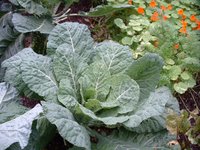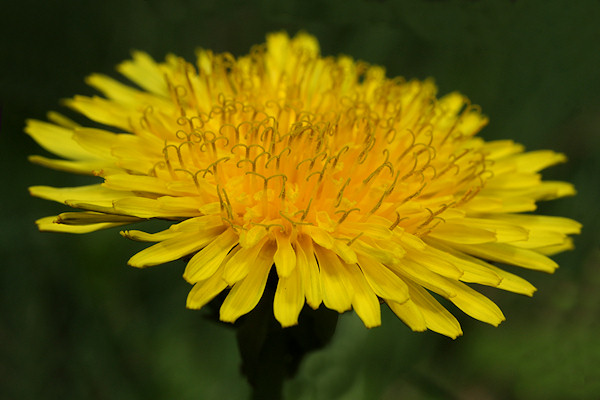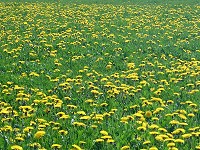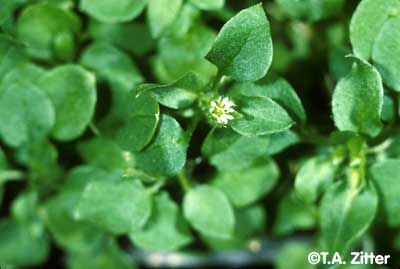
But, like a house cat, I kept coming back. At first, on the pretense of making sure the house was okay without me. Then, over the fence, I spied some edibles now and then. In June and July, August, and September, I grabbed the odd bunch of collards just because they were there. But last Sunday, I came with the full intention of pirating what was left of the summer bounty.
My former neighor spied me and yelled, "Call the police!" with a big smile. I told him the collards were calling me. Apparently, that siren call has no temptation for him, a meat and potatoes guy.
Here in my former garden was a collard patch the size of a queen size bed that held plants as thick as pencils in a jar. Now what is amazing about this...I didn't plant collards there. No, I didn't even plant any the year before. The mommas of these prodigies were planted in 2004, overwintered until 2005, then dropped seed. When I left this house, there was a shadow of green under the matriarchs.
With no gardener, no water from the hose, no cultivating, no thinning, no fertilizing, and scorching summer heat these collards, packed like asparagus in a can, THRIVED. That is quite an achievement. That's almost scarey. They are 2-3 feet tall and loaded with leaves. Now, I'm not going to lie to you, the leaves were uglier than sin, some with more holes than leaf from the cabbage worms. They would not win a prize at the county fair.
But here is the kicker. Even the ugliest, most cracked, curled and deformed doily of a leaf when cooked up was blissfully  tender and sweet. Even the half inch woody stems defy description as fine cuisine. HOW CAN THAT BE?
tender and sweet. Even the half inch woody stems defy description as fine cuisine. HOW CAN THAT BE?
After I picked a bushel from the prodigies last week, blanched and froze them, I had a basket of stems and gross leaves pulled off the freezer stock as recommended by the blanching website. I cooked that ugly throw away stuff and guess what? They were so delicious, I raced up the hill for more. I was hoping my former house didn't sell before I peeled all the collards out of there.
All the leaves I had left behind the day before as too moth eaten, raggedy, or crusty to be palatable, I greedily loaded into my bags. Once they were blanched, they were impossible to tell from the 'melt in your mouth' ones. That is some kind of magic. Try that with old spinach, kale or chard and you want to spit them out!
Did I mention that collards are in the highest recommended category for all blood types?
In conclusion, for sheer durability, drought resistance, reseeding genius, tastiness , palatability, and nutrition, these collards are unparalleled. Garden grown surpasses store bought by leaps and bounds. Or is it our Montana 'banana belt' soil here along Flathead Lake that adds something special? These leaves from my former garden are tender and sweet, every one, more so than I remember from past years.
Another scenario in this 'what are they up to' business is that maybe plants I have cared for, neglected, observed, watered, failed to water, and appreciated, develop differently than factory farmed plants. We gardeners have always suspected so. Perhaps when the next generation gets seeded directly from the parental pod, genetic vigor increases. These plants are profoundly resilient and persistent by anyone's yardstick. Monday they had a quarter inch of frost on them and today they looked totally unharmed.
Other gardeners have obvserved the connection between plants and gardener. Collards in my garden have done things I had never seen plants do before. They planted and raised themselves. They beat back the weeds. They partied through long stretches of 90-100 degree weather without a soaker hose or sprinkler. They manufactured seed true to type over 2-3 generations. They withstood parasites with minimal damage, and under all this duress, transformed their leaves into something infinitely more edible than the norm.
Did it have anything to do with me cheering them on from the sidelines? As Dr. Masaru Emoto revealed in The Hidden Messages in Water, molecules are literally re-engineered by the emotional intention of the viewer. Gardeners, even absentee, are the ultimate observers and witnesses of this amazing process of sun, water, seed and intention.
What happens when we charge our food with these positive intentions and are in turn charged by eating plants so entrained? A powerful spiral of wellness with unlimited potential seems possible. It gives the term food chain a whole new meaning. It turns gardening into some kind of sacrament. Like me, you have probably already noticed there is something strange and wonderful going on out there in the garden, the forest, and the weed patch. Let's share some stories about plants and foraging. I look forward to your comments
Happy grazing and fun foraging!

 My very first experience with plant weirdness occurred when I was 7 1/2 years old. I was with my Mom in the backyard. She was working the flower bed. I noticed a dandelion, really noticed it or did it notice me? The yellow flower was SO YELLOW. The more I looked the bigger and yellower it got. Seemed like we were almost talking. Wow.
My very first experience with plant weirdness occurred when I was 7 1/2 years old. I was with my Mom in the backyard. She was working the flower bed. I noticed a dandelion, really noticed it or did it notice me? The yellow flower was SO YELLOW. The more I looked the bigger and yellower it got. Seemed like we were almost talking. Wow.


